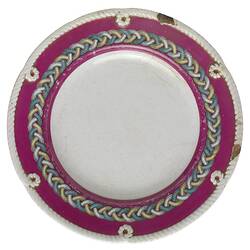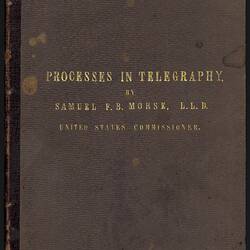Samuel McGowan, General Superintendent of the Electric Telegraph in Victoria designed and had built a telegraphic device to allow train crews to communicate with stations in the event of accident or operating problems. He described the device in his report to Parliament for 1866.
Excerpt from Report of the General Superintendent of the Electric Telegraph for the year ending 31st December 1866, pp. 22-23
NEW INSTRUMENTS
Within the past year I have designed and caused to be made, under my supervision -
.....
2. An automatic instrument, for the use of guards or engine-drivers on the railways, to be used for communicating with any station in the event of accident or interruption to traffic.
I have so arranged this instrument that the person using it need not have any knowledge of telegraphs, further than to distinguish between a single and a double stroke of a light hammer on a small bell, the one being a negative, and the other an affirmative signal.
The instrument is exceedingly simple in construction, and not likely to become disarranged; in size it occupies about the space of an ordinary chronometer, such as is commonly used on shipboard.
It is composed of an electromagnet, a small bell, an earth wire switch, and a spindle carrying eleven (11) type wheels, over which are placed spring contact pieces, controllable at the will of the person using the instrument. By means of small ivory knobs, on each of which is engraved a number from 1 to 0.
To place the instrument "in circuit" only three connections are necessary, two for the main wires, and one for the earth wire; the connections are plainly labeled (engraved on the clamp screws), so that it would be difficult for any mistake to occur. The signals would, of course, be conveyed by the numbers, to each of which (or combination) a signification would be attached.
I propose to place "communicating points", at distances of one mile apart, along the railway lines; so that in the event of an accident necessitating the use of the instrument, the guard, or the engine-driver, could never be more than half a mile from such a point. Brief printed instructions would accompany each instrument, secured inside the lid of the case, and each guard would be provided with an instrument and means of reaching the "communicating points", as the latter would be about eight or nine feet above the ground, so as to avoid the probability of their being interfered with by idle or evil-disposed persons.
The cost of the instruments, if made here, would not exceed twelve pounds (£12) each, and the cost of placing the "communicating points" would amount to about thirty shillings per mile. In a future Report I shall be prepared to give drawings and details of the instruments above described."
The device was also exhibited at the International Exhibition 1872-3 and was described in the catalogue.
Excerpt from Catalogue of International Exhibition 1872-3. Victorian Exhibition 6 November 1872 - 16 January 1873. Exhibits in Division III - Scientific Inventions and New Discoveries Postmaster-General, The, Melbourne
1157. Section of Telegraph Pole for Railway, showing Insulators, Brackets, Conducting wires, &c., in position. With portable Instruments for the use of Railway Guards in the event of Accident, &c. Designed by S. W. McGowan, Esq. Inspector of Postal and Telegraph Service.
The instrument exhibited herewith is a portable Transmitting and Receiving apparatus, designed on the principles of Morse's electromagnetic telegraph, for the use of railway guards in the event of accident or interruption to the traffic. It consists of an electro-magnet, arranged for working on the main circuit of any telegraph line, a lever-switch (for shutting off the up or down line, as may be necessary), a spindle carrying ten discs, with platina-toothed connections for numerals from 1 to 0, and having above the spindle corresponding lever keys, with platina contact points, to operate against the toothed periphery of each disc, so as to connect or disconnect the main circuit at pleasure.
The working of the instrument is purely mechanical. It is not necessary that the person using the apparatus should possess any knowledge of telegraphic manipulation. The signals are conveyed by numerals, either in single or combined form, arranged to convey intelligence relating to accident of any description. The reply signal is given in the ordinary manner, by the signal key, from the office receiving the accident signal and is heard by the guard (or person communicating) on the bell.
The transmitting spindle is revolved by hand, at the rate of about eight revolutions per minute.
More Information
-
Keywords
-
Authors
-
Article types
![[Ganger and dog sitting on ganger's trolley, Hastings district, circa 1920.]](/content/media/20/152870-small.jpg)

